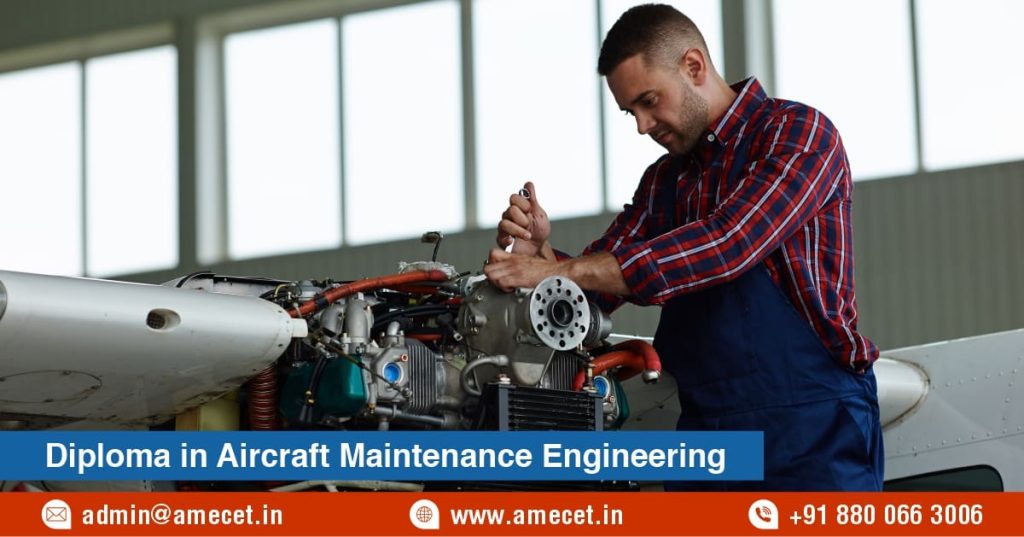A Diploma in Aircraft Maintenance Engineering is a specialized program designed to train students in the maintenance, repair, and inspection of aircraft. This diploma typically spans two to three years and covers essential topics such as aviation safety, aircraft systems, and maintenance practices. Students gain both theoretical knowledge and practical skills through classroom instruction and hands-on training. Graduates are prepared to work as aircraft maintenance engineers, ensuring the safety and airworthiness of aircraft. This diploma serves as a foundational step towards obtaining necessary certifications and advancing in the aviation maintenance industry.
Program Structure
The program structure of a Diploma in Aircraft Maintenance Engineering typically spans two to three years, combining theoretical and practical training. Students learn about aircraft systems, maintenance practices, and aviation safety. The curriculum includes modules on avionics, aerodynamics, and propulsion systems. Practical workshops provide hands-on experience. The program also features industry internships, comprehensive exams, and continuous assessments, ensuring students are well-prepared for certification and careers in aircraft maintenance.
Program Structure:
- Duration: Two to three years.
- Theoretical Training: Classroom instruction.
- Practical Training: Hands-on workshops.
- Aircraft Systems: Comprehensive study.
- Maintenance Practices: In-depth learning.
- Internships: Industry exposure.
- Assessments: Continuous evaluation.
- Certification Preparation: Exam readiness.
Admission Requirements
Admission requirements for a Diploma in Aircraft Maintenance Engineering typically include a high school diploma or equivalent, with a focus on mathematics and science subjects. Applicants must meet a minimum age requirement, usually 17 or 18 years old. Proficiency in English is essential. Some programs may require entrance exams or interviews. Additional requirements can include medical fitness certificates, background checks, and relevant work experience in the aviation field.
Admission Requirements:
- High School Diploma: Required.
- Math and Science Focus: Essential.
- Minimum Age: 17 or 18 years old.
- English Proficiency: Necessary.
- Entrance Exams: Possible requirement.
- Interviews: Sometimes needed.
- Medical Fitness: Certificate required.
- Background Checks: Often conducted.
Curriculum and Training
The curriculum and training for a Diploma in Aircraft Maintenance Engineering encompass a blend of theoretical and practical learning. Core subjects include aerodynamics, avionics, propulsion systems, and aircraft structures. Practical training involves hands-on workshops, simulated environments, and industry internships. Students also learn about safety regulations, maintenance protocols, and troubleshooting techniques. Continuous assessments and exams ensure competency. The program prepares students for certification and successful careers in aircraft maintenance.
Curriculum and Training:
- Aerodynamics: Core subject.
- Avionics: Comprehensive study.
- Propulsion Systems: Detailed learning.
- Aircraft Structures: Key topic.
- Hands-On Workshops: Practical experience.
- Industry Internships: Real-world exposure.
- Safety Regulations: Essential knowledge.
- Troubleshooting Techniques: Skill development.
Certification and Licensing
Certification and licensing in Aircraft Maintenance Engineering are critical for career advancement. Graduates must pass exams from aviation authorities such as the FAA or EASA. Certifications include categories like airframe, powerplant, and avionics. Practical experience, often gained through internships, is required. Continuing education is essential to maintain and update licenses. Employers highly value certified professionals, enhancing job prospects and credibility in the aviation industry.
Certification and Licensing:
- Exams: FAA or EASA.
- Certification Categories: Airframe, powerplant, avionics.
- Practical Experience: Required internships.
- Continuing Education: Maintain licenses.
- Regulatory Bodies: Approve certifications.
- Job Prospects: Enhanced by certification.
- Credibility: Increased with licensing.
- Professional Growth: Supported by certifications.
Benefits of the Diploma
Earning a Diploma in Aircraft Maintenance Engineering offers numerous advantages. Graduates gain specialized knowledge and practical skills, making them highly employable in the aviation industry. The diploma provides a pathway to certification and licensing, ensuring regulatory compliance. It opens doors to diverse career opportunities, from airlines to aerospace companies. Students benefit from industry connections and internships, leading to hands-on experience and job placement. This diploma enhances job security and career growth.
Benefits of the Diploma:
- Specialized Knowledge: In-depth learning.
- Practical Skills: Hands-on experience.
- Employability: High demand in aviation.
- Certification Pathway: Meets regulatory requirements.
- Career Opportunities: Various roles available.
- Industry Connections: Valuable networking.
- Internships: Real-world training.
- Job Security: Stable career prospects.
A Diploma in Aircraft Maintenance Engineering is a valuable qualification that equips students with the essential skills and knowledge needed in the aviation industry. This program offers a comprehensive curriculum, blending theoretical and practical training to prepare graduates for certification and diverse career opportunities. The hands-on experience, industry connections, and internships provide a solid foundation for a successful career. The diploma ensures regulatory compliance, enhances employability, and offers job security. Pursuing this diploma opens doors to a dynamic and rewarding field, making it an excellent choice for those passionate about aviation and aircraft maintenance.

